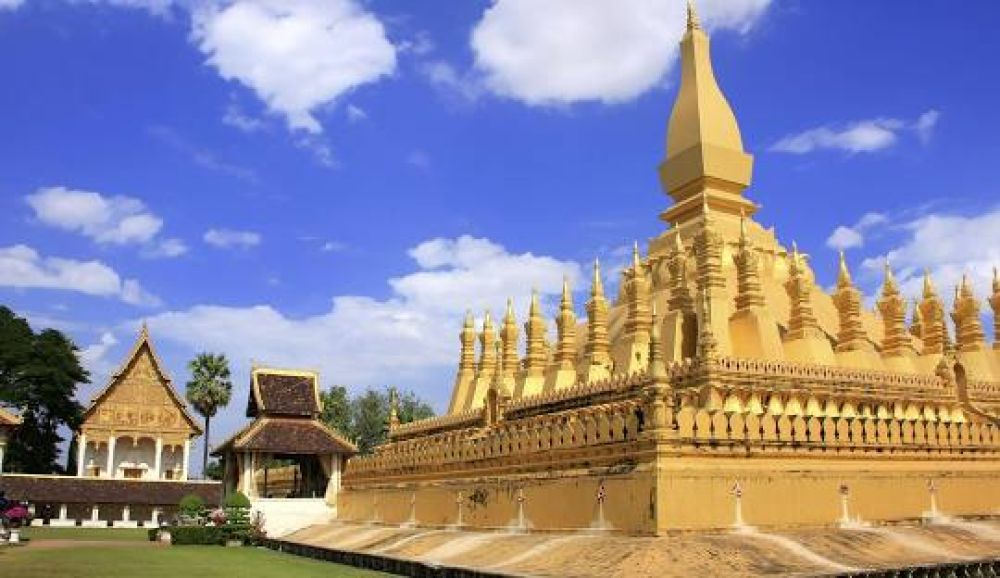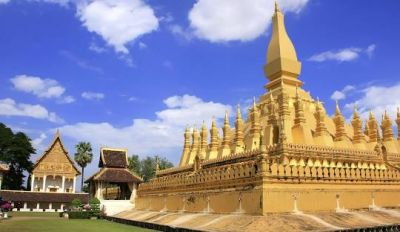

Pha That Luang, or the Great Stupa, is a gold-covered Buddhist stupa in the center of Vientiane, Laos. It is the most significant religious and national monument in Laos. Visitors can embark on a guided tour that delves into the history and significance of this sacred site. Learn about its origins dating back to the 3rd century, its reconstruction in the 16th century, and its symbolic design representing Buddhist cosmology. Wander through the cloisters surrounding the stupa, observe the detailed artwork, and visit the nearby temples and pavilions filled with Lao and Buddhist artifacts. Guides will share insights into Lao culture, the significance of Buddhism, and the story of King Setthathirath who ordered the construction of the magnificent stupa.
Experience the serene beauty of sunset at Pha That Luang, where the golden hue of the stupa reflects the warm twilight colors. Visitors gather to watch this majestic transition as the sun sets and the stupa lights up against the evening sky. A peaceful moment that provides an opportunity for personal reflection or photography enthusiasts to capture stunning shots. No guided narrative is needed for this activity; just a moment to appreciate the tranquility and grandeur of this sacred space. It's a self-guided experience, with no rush as you soak in the atmosphere of the evening calls to prayer and the night market beginning to bustle in the distance.
Engage in a spiritual journey with a meditation and mindfulness retreat at the holy grounds of Pha That Luang. This is an immersive experience where participants can connect with their inner self and practice meditation led by experienced local monks. The session includes learning about Buddhist principles, chanting, and guided meditation that can be a transformative experience for attendees. The serene and spiritual atmosphere of Pha That Luang provides the perfect backdrop for this soul-enriching activity, suitable for beginners and enthusiasts alike. Embrace the tranquility, learn about Lao spiritual practices, and carry with you a sense of inner peace.
Each year, usually in November, the Pha That Luang Festival, a Buddhist festival, is celebrated with great pomp and show. During the festival, visitors can witness a cultural show that presents traditional Lao dances, music, and performances. It is a showcase of the rich heritage and artistic expressions of Laos. The stupa is spectacularly lit up, and the festival includes a vibrant procession, religious ceremonies, and market fairs. The cultural show offers an insight into Lao traditions and an unforgettable experience under the backdrop of the nation's beloved stupa. The festival generally lasts a week, with activities peaking towards the final days.
Participate in a traditional Lao Baci ceremony, which is often held to honor guests, celebrate special occasions, or as a cultural experience. The Baci involves a series of rituals and chanting by an elder, the tying of white cotton strings around guests' wrists for good luck and to welcome spirits, and the sharing of food and Lao Lao (rice whiskey). Pha That Luang often serves as a location where such ceremonies are organized for both locals and travelers, offering a deep dive into the spiritual and communal life of the Laotians. This unique experience provides an intimate look at Lao culture and an opportunity to connect on a more personal level with its people.
Pha That Luang, with its shimmering golden surface and grandeur, is a photographer's dream. A photography excursion at this site allows enthusiasts to learn from a professional photographer about capturing the perfect shot of the stupa and surrounding architecture. From the basics of composition to advanced techniques in lighting, this activity caters to all skill levels. The excursion also teaches participants about the history of the temple. Early morning or late afternoon are the best times to go for the best natural lighting conditions, and the golden hour offers the most breathtaking photographs of this iconic Laotian symbol.
While visiting Pha That Luang, take the opportunity to explore the Patuxai Victory Monument, which is a short drive away. Known as the Arc de Triomphe of Vientiane, it commemorates Lao independence from France and offers panoramic views of the city from the top. Visitors can climb the stairs to the top, marvel at the intricate, traditional Lao motifs adorning the structure, and browse the souvenir shops located at the base. The monument is surrounded by Patuxai Park where you can take a relaxing stroll or enjoy local snacks from street vendors. It's a great way to combine historical sightseeing with a leisurely activity.
At Pha That Luang, art lovers can get their hands-on experience in a Buddhist sculpture workshop. Learn the ancient craft of making religious statues, which holds significant cultural value in Laos. Skilled artisans guide participants through the process of sculpting, including material selection, shaping techniques, and detailing, drawing inspiration from the magnificent stupa and surrounding statues. This workshop is not only a creative outlet but also a remarkable way to understand the importance of devotional art in Lao Buddhism. No prior experience is required, and you'll leave with your handcrafted work of art and a deeper appreciation for Lao cultural arts.
Combine your visit to Pha That Luang with a hands-on cooking class to discover the flavors of Laotian cuisine. Sourced from local markets with fresh ingredients, learn how to prepare traditional dishes such as sticky rice, larb, and papaya salad. Cooking classes often take place in a local home or a specialized school where you can immerse yourself in Lao culture by cooking and eating with locals. The experience typically includes a market visit to learn about local produce, a cooking lesson where you prepare several dishes, and a meal where you get to enjoy the fruits of your labor.
Participating in Tak Bat, or the morning almsgiving, is a profoundly humbling experience available near Pha That Luang. Early risers can join local devotees in this daily Buddhist tradition by offering food to passing monks. This solemn ritual starts at dawn and symbolizes humility and respect in the community. Visitors are advised to dress modestly and follow the local etiquette for almsgiving. The experience creates a spiritual connection and offers a unique perspective of the local religious customs. Many find the ritual to be a moving experience, emphasizing sharing and mindfulness in everyday life.
